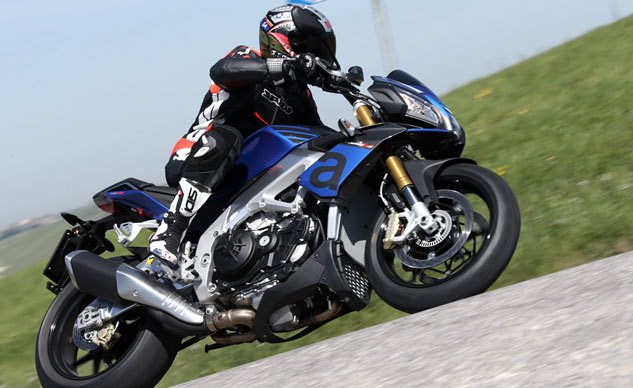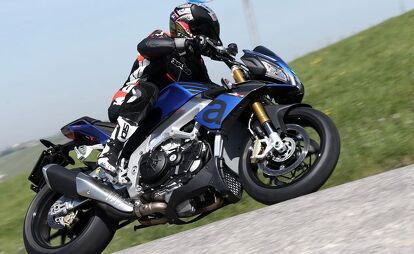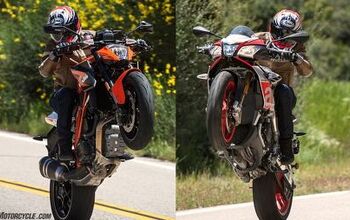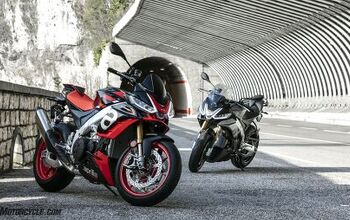2016 Aprilia Tuono V4 1100 RR First Ride Review
Lusty streetfighter gets larger engine, more power, revised ergos and updated electronics
My affection for the Tuono V4 is well documented on the pages of MO, and I’ll jump at any chance to take one for a ride on a twisty road. If the ride is in Italy on an upgraded and faster version, well, step aside.
2016 Aprilia Tuono V4 1100 RR
| Engine | 19.5/20 |
| Suspension/Handling | 13.5/15 |
| Transmission/Clutch | 9.5/10 |
| Brakes | 8.75/10 |
| Instruments/Controls | 3.75/5 |
| Ergonomics/Comfort | 8.0/10 |
| Appearance/Quality | 8.75/10 |
| Desirability | 9.5/10 |
| Value | 8.0/10 |
| Overall Score | 89.25/100 |
2014 Aprilia Tuono V4R ABS Review
When it comes to lust-worthy streetfighters, Aprilia’s Tuono V4 is one of our favorites around here. It’s epitomized the class ethos of stripping a superbike of its bodywork and fitting a higher handlebar to create a raw sports roadster, first in 2002 with a version of the RSV1000 V-Twin, then in 2011 when a crazier Tuono debuted based on the RSV4’s four-cylinder motor. Retuned for streetfighter duty – don’t say detuned – the Tuono’s V-4 motor pumped out 150 horsepower and out-pulled the RSV4 engine at all points of their powerbands below 12,000 rpm, as seen on the dyno chart in our review of the 2012 model.
2012 Literbike Streetfighter Shootout + Video
To MO editors, the Tuono’s appeal is so strong that we couldn’t declare our choice for best streetfighter of 2014 until we had a chance to throw it in next to KTM’s 1290 Super Duke R and BMW’s S1000R. Ultimately, the Tuono didn’t win our objective comparison, but it excelled in subjective voting.
For 2015 – in the U.S. labelled as a 2016 model – the Tuono V4 gets a comprehensive upgrade, most obviously by a larger engine via a 3mm overbore to 1077cc. Torque is now up to a claimed 89.2 lb-ft at 9000 rpm when rated at its crankshaft; formerly 88.3 at 9500, and horsepower rises by a quintet, now to a claimed 175 ponies. Most notable is the bump in midrange power, nearly 20 extra horses at 8000 rpm, according to Aprilia.
It’s a spec that feels believable when twisting the throttle on the tight roads surrounding the Misano World Circuit Marco Simoncelli where I was to test Aprila’s significantly updated RSV4 later in the day. The Tuono’s luscious motor now responds with much greater urgency in its middle revs and makes an admirable wheelie machine even more eager to float its front wheel. Like its RSV4 brother, the Tuono 1100 is fitted with new Pankl conrods that combine for 400 grams less weight, a new crankshaft with smaller-diameter crankpins but 450 grams of additional weight, and a new crankcase with better ventilation to reduce parasitic drag.
The Tuono has always been a tall bike for such a compact and sporty roadster, but this new iteration has been made slightly lower by tweaks to its fully adjustable Sachs suspension: fork tubes raised in the triple clamps (with 5mm extra offset) and a new shock for the rear. These alterations steepen the rake angle from 25.1° to 24.7° and reduce trail from 107.4mm to 99.7mm, quickening steering responses and reducing the Tuono’s overall center of gravity. Its swingarm is said to be 6mm longer, while its wheelbase is up a scant 3mm.
A side benefit of the Tuono’s lower stance is a seat height reduced by about half an inch (15mm) to 32.5 inches. It’s still tall but a bit more manageable. The seat padding is a new foam material that prevents hardening from crystallization, and it feels a bit comfier than on previous generations. Ergonomics are marginally altered via handlebars narrower by 6mm and purportedly slightly lower, but it must be a marginal change because I didn’t notice a difference.
What I did notice was one of my all-time favorite powertrains and its newfound burliness. Clutch take-up is quite manageable, and its slick gearbox impresses – upshifts are seamless thanks to well-sorted quickshifter programming. The real highlight is the sonic delight of the 65-degree V-4 engine, which is nothing short of rapturous and, to my ears, is worth many extra dollars. With the 1100’s motor mods, Aprilia has made this engine even more enjoyable – its boosted midrange is impossible to ignore and makes for a scintillating ride.
What might be a feral animal is tamed via the third-generation of Aprilia Performance Ride Control electronic rider aids teamed with a more powerful ECU. The ride mode choices loses the power-clipping Rain mode and now employs Sport, Track and Race settings, each tweaked for smoother responses. Each map was retuned to deliver less aggressive responses to good effect – I selected Track mode and was pleased at how manageable it performed. Each ride mode also has its own engine-brake management parameters to work along with the tranny’s slipper clutch, with less overrun braking in Track and Race modes.
The APRC suite of electronic rider aids include the latest generation of traction control (adjustable on the fly), wheelie control and launch control. Aprilia gets bonus points for the independent operation of TC and WC – I’m much more interested in the benefits of TC than WC, and I promise this will be the only test of a Tuono written by me that doesn’t include a wheelie shot!
The Tuono 1100 also shares with the RSV4 the V4-MP app that links your smartphone to the bike. This gizmo records data like speeds, gears and throttle positions, plus display things like rear-wheel slip, lean angle and g-force data. And when used on a racetrack, the bleeding-edge app can be used to select different TC and WC settings at various points around the track – like a MotoGP bike. More info on the V4-MP can be found in my 2016 RSV4 review.
It’s ironic that a tech-packed motorcycle like the Tuono 1100 is equipped with an instrument panel that seems like it’s been around as long as my second-grader. The boxy LCD display looks dated next to contemporary panels, especially those of the TFT variety. But, really, this is one of the few demerits – and a barely mentionable one – to this brilliant sporting machine.
The Tuono’s other demerit concerns weight. Aprilia’s specs state the 1100 has lost 2 lbs, now claimed to scale in at 406 lbs without any fluids or a battery. However, our last Tuono pushed the scales with 474 lbs of mass with its 4.9-gallon tank full, two dozen pounds more than a fueled BMW S1000R.
Otherwise, the Tuono 1100 RR is a gem of a naked sportbike that can tackle everything from commuting to trackdays to sport-touring. Its dynamic and playful personality delivers a smile-per-mile rating in the upper echelon of what’s possible from a sporting motorcycle.
+ Highs
- 77cc more fun!
- Powertrain inspires lust
- Eager and capable hooligan
– Sighs
- 25 lbs heavier than S1000R
- Stiff streetfighter competition
- Dated instrumentation
Aprilia Tuono V4 1100 RR Specifications [Tuono V4 1100 Factory data in brackets] | |
|---|---|
| Engine Type | 65° V-4, 4-stroke, liquid cooled engine with dual overhead cams and four valves per cylinder |
| Bore and stroke | 81.0 x 52.3 mm |
| Capacity | 1077 cc |
| Maximum power at crankshaft | 175 HP (129 kW) at 11,000 rpm |
| Maximum torque at crankshaft | 120 Nm at 9,000 rpm |
| Fuel system | Airbox with front dynamic air intakes. 4 Weber-Marelli 48-mm throttle bodies with 4 injectors and latest generation Ride-by-Wire engine management. Choice of three different engine maps selectable by the rider with bike in motion: T (Track), S (Sport), R (Road) |
| Exhaust | 4 into 2 into 1 layout, single oxygen sensor, lateral single silencer with ECU-controlled bypass valve and integrated trivalent catalytic converter |
| Alternator | Flywheel mounted 450 W alternator with rare earth magnets |
| Lubrication | Wet sump lubrication system with oil radiator and two oil pumps (lubrication and cooling) Gearbox 6-speed cassette type gearbox |
| Clutch | Multi-plate wet clutch |
| Final Drive | Chain: 42/16 |
| Front Suspension | Inverted 43mm Sachs fork, [Öhlins fork with TIN surface treatment]. Forged aluminum radial caliper mounting bracket. Adjustable spring preload and hydraulic compression and rebound damping; 120mm travel |
| Rear Suspension | Double braced aluminum swingarm; Sachs monoshock fully adjustable in: spring preload, hydraulics in compression and rebound [Öhlins Racing monoshock with piggy-back, fully adjustable in: spring preload, wheelbase length, hydraulics in compression and rebound]; 130mm of travel |
| Front Brakes | Dual 320mm floating stainless steel discs with lightweight stainless steel rotor with 6 studs [aluminum flange] Brembo M432 monobloc radial calipers with four 32mm opposing pistons. Sintered pads. Axial pump master cylinder and metal braided brake hoses. |
| Rear brake | 22omm disc; Brembo floating caliper with two 32mm pistons. Sintered pads. Master cylinder with built in reservoir and metal braided hose. Bosch 9MP ABS, adjustable to 3 maps equipped with RLM (can be disabled). |
| Wheels and Tires | Cast aluminum; Front: 3.5”x17” Rear: 6.00”x17” Radial tires. Front: 120/70ZR-17 Rear: 190/55ZR-17 (alternative: 190/50ZR-17; 200/55ZR-17) [200/55ZR-17] |
| Saddle height | 32.5 inches |
| Steering angle | 24.7° |
| Trail | 100mm (3.94 in.) |
| Wheelbase | 57.0 in. |
| Weight | 406 lbs (without battery and fluids) |
| Fuel Capacity | 18.5 liters (4.88 gallons), including 4-litre (1-gallon) reserve |
More by Kevin Duke









































































Comments
Join the conversation
These bikes are far more than the sum of their parts to ride. I can't even imagine comparing it with the S1000R, it's like comparing a Ferrari F40 (Tuono) to a GT-R (S1000R)... both fast and maybe similar in straight-line performance, but you would have to be a soulless commuter to not choose the Italian.
The question I wonder about when you see the multi and now XR are they really better then sport naked what's truly an all round bike KTM superduke 1290 oe Tuono which you can tour, ride on the track and commute ? or is it a multi or XR better ?